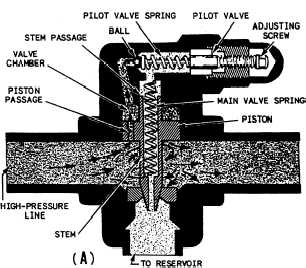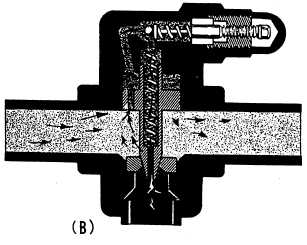same pressure acting over different areas produces
forces proportional to the areas. It also requires
a greater force to close the valve than was required
to open it. As a result, the valve will not close until
the system pressure has decreased to a certain
point below the pressure required to open it.
Let us assume that a valve of this type is set
to open at 500 psi. (Refer to fig. 6-12.) When the
valve is closed, the pressure acts on area A. If this
area is 0.5 square inch, an upward force of 250
pounds (500 0.5) will be exerted on the valve
at the moment of opening. With the valve open,
however, the pressure acts on area B. If area B
is 1 square inch, the upward force is 500 pounds,
or double the force at which the valve actually
opened. For the valve to close, pressure in the
system would have to decrease well below the
point at which the valve opened. The exact
pressure would depend on the shape of the valve
element.
In some hydraulic systems, there is a pressure
in the return line. This back pressure is caused
by restrictions in the return line and will vary in
relation to the amount of fluid flowing in the
return line. This pressure creates a force on the
back of the valve element and will increase the
force necessary to open the valve and relieve
system pressure.
It follows that simple relief valves have a
tendency to open and close rapidly as they “hunt”
above and below the set pressure, causing
pressure pulsations and undesirable vibrations
and producing a noisy chatter. Because of the
unsatisfactory performance of the simple relief
valve in some applications, compound relief valves
were developed.
Compound relief valves use the principles of
operation of simple relief valves for one stage of
their action—that of the pilot valve. Provision is
made to limit the amount of fluid that the pilot
valve must handle, and thereby avoid the
weaknesses of simple relief valves. (A pilot
valve is a small valve used for operating another
valve.)
The operation of a compound relief valve is
illustrated in figure 6-13. In view A, the main
valve, which consists of a piston, stem, and spring,
is closed, blocking flow from the high-pressure
line to the reservoir. Fluid in the high-pressure line
flows around the stem of the main valves as it
flows to the actuating unit. The stem of the main
valve is hollow (the stem passage) and contains
the main valve spring, which forces the main valve
against its seat. When the pilot valve is open the
stem passage allows fluid to flow from the pilot
Figure 6-13.—Operation of compound relief valve,
6-8





